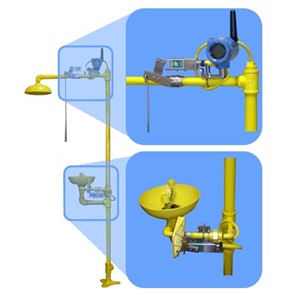This week at the EHS (Environmental, Health & Safety) Seminar in Galveston, Texas, Emerson’s Michael Machuca had two presentations to give. In today’s post, I’ll cover the first, Digital Solutions to Reduce Emergency Response Time.
He opened by noting how response time is critical in an emergency. Injuries are reduced the quicker people are out of harm’s way. Location awareness mustering digital technology can help identify who made it safely out of the area and who may need help. Emerson’s Location Awareness technology provides relevant-time, safety-focused monitoring of your most valued resource—your people. This technology can also offer low-activity alerts and emergency alerts by plant staff.
Wireless sensor technology can also be applied to safety showers and eye wash stations to notify plant staff when someone has used these safety devices. Combined with location awareness, the individual who needs help is immediately identified for rapid support. Geofencing is another application to keep plant staff safe by avoiding zones for which they are certified to be located. Privacy can be addressed by creating roles from fully anonymous to fully identifiable.
Michael shared many other ways to protect personnel and reduce response times. Unplanned releases of toxic or combustible sources can occur in many areas, including passive equipment failures such as gasket/seal failures, seals on rotating equipment, human error on valve positions, and sabotage or terrorism. Flame & gas detection solutions can help to reduce incidents.
Ultrasonic gas detection, fixed point gas detection, and open path gas detection technologies are available to help drive improved safety performance. Rosemount Incus Ultrasonic Gas Leak Detectors respond to sounds generated by escaping gas at ultrasonic frequencies providing instant detection of pressurized gas leaks over a wide area. The sound is at a level that most people can’t hear and is not affected by the loud audible noise that may occur in a typical facility.
Various fixed-point gas detectors include catalytic bead combustible, infrared point, and electrochemical. These are all based on gas diffusion, where the gas needs to reach the sensor, akin to “smelling” the gas. The Net Safety Millennium SC310 Catalytic Bead Combustible Gas Sensor detects combustible gases by oxidizing in the detector’s catalyst causing the rising temperature to create an alert condition.
The Rosemount 925FGD Fixed Gas Detector uses non-dispersive infrared (IR) technology and provides early combustible gas leak detection. These gases have unique absorption characteristics when exposed to IR energy. These detectors are immune to poisoning and unaffected by high concentrations of hydrocarbons.
The Rosemount 628 Series of electrochemical toxic gas sensors monitor for hydrogen sulfide (H2S), carbon monoxide (CO), and oxygen depletion (O2). The electrodes/electrolyte are chosen based on the target gas, and the sensor operates when the target gas oxidizes or reduces on the sensing electrode generating an electrical signal.
Michael next discussed open-path gas detection. These consist of a transmitter and receiver pair and provide distance coverage via line-of-sight IR absorption detection (as opposed to point IR). The Rosemount 935 Open Path Combustible Gas Detector continuously monitors hydrocarbon gases, even in harsh environments where dust, fog, rain, snow, or vibration can cause high amounts of obscuration.
The final digital technology he discussed to improve safe operations and response times was flame detection. The Rosemount 975MR Multi-Spectrum Infrared Flame Detector accurately analyzes the multi-spectral signals of hydrocarbon gas or liquid fires by utilizing four separate IR sensors. These sensors provide excellent immunity to false alarms such as welding, lightning, x-rays, sparks/arcs, and sunlight. They also have very long-range detection. The Rosemount 975UR Ultraviolet Infrared Flame Detector senses radiant energy in the short wave section of the electromagnetic spectrum’s ultraviolet and infrared portions. It can detect hydrocarbon, metal-based, hydrogen, and Silane fires. They are fast responding and suitable for indoor and outdoor applications.
Follow the links above for the many ways to help drive faster emergency response times and provide safer operations.




